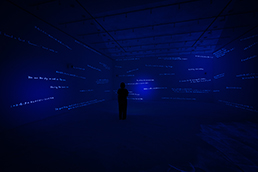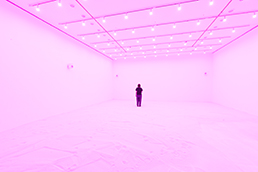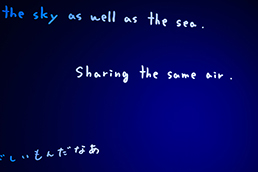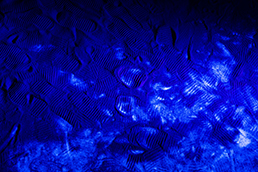Breathe You
2020
Sound Installation
luminescent paint, black light, plant growth lighting, speaker, sound
Contemporary Art Center, Art Tower Mito, Japan
Yoichi Kamimura searches for ways to perceive the landscape through the visual or auditory senses, and approaches environments around the world via field recordings and, based on the materials and concepts he attains there, creates installations, paintings, sound performances, sound art, and more. The field recordings he has made in the Shiretoko Peninsula since 2019 have seen him search for a borderless ecology encompassing humankind and nature via the various phenomena that involve drift ice.
Breathe You is inspired by his experience sensing the outside of the human world within a place of darkness when he undertook field recordings on a sea of drift ice. The artist has made a new installation that fills the entire space with a meditative soundscape comprising various environmental noises produced by drift ice, the cries of marine life, and a mixture of human breathing or whistling that recreates the now rarely heard phenomenon of gsingingh drift ice.
This occurs when air is pushed out through the gaps in the ice. Due to the decreasing amount of drift ice in the sea, there are now fewer opportunities to hear this gsingingh and it is hardly known even in Shiretoko. When attempting to grasp this absent sound from local peoplefs recollections of drift ice, our breathing seems to synchronize with the air pushed out through the gaps in the drift ice and released, conveying a vivid sense of the air that is taken into our bodies and then expelled in order to breathe.
Is this sensation a dubious kind of insecurity aware that metabolism attendant on human activities is causing the drift ice to melt through climate change? Or is it the realization of the nonhuman that exists within us, whereby even the phenomenon so indispensable to humans that is breathing is made possible by the oxygen generated by other organisms? The answers to these questions lie at the disquieting border between the human and natural worlds. And it is surely at the ambivalent connections that appear among us and the things like air that we take for granted in our lives where we can discover the ecological future of humankind and nature.
@@@
2020
Sound Installation
luminescent paint, black light, plant growth lighting, speaker, sound
Contemporary Art Center, Art Tower Mito, Japan
Yoichi Kamimura searches for ways to perceive the landscape through the visual or auditory senses, and approaches environments around the world via field recordings and, based on the materials and concepts he attains there, creates installations, paintings, sound performances, sound art, and more. The field recordings he has made in the Shiretoko Peninsula since 2019 have seen him search for a borderless ecology encompassing humankind and nature via the various phenomena that involve drift ice.
Breathe You is inspired by his experience sensing the outside of the human world within a place of darkness when he undertook field recordings on a sea of drift ice. The artist has made a new installation that fills the entire space with a meditative soundscape comprising various environmental noises produced by drift ice, the cries of marine life, and a mixture of human breathing or whistling that recreates the now rarely heard phenomenon of gsingingh drift ice.
This occurs when air is pushed out through the gaps in the ice. Due to the decreasing amount of drift ice in the sea, there are now fewer opportunities to hear this gsingingh and it is hardly known even in Shiretoko. When attempting to grasp this absent sound from local peoplefs recollections of drift ice, our breathing seems to synchronize with the air pushed out through the gaps in the drift ice and released, conveying a vivid sense of the air that is taken into our bodies and then expelled in order to breathe.
Is this sensation a dubious kind of insecurity aware that metabolism attendant on human activities is causing the drift ice to melt through climate change? Or is it the realization of the nonhuman that exists within us, whereby even the phenomenon so indispensable to humans that is breathing is made possible by the oxygen generated by other organisms? The answers to these questions lie at the disquieting border between the human and natural worlds. And it is surely at the ambivalent connections that appear among us and the things like air that we take for granted in our lives where we can discover the ecological future of humankind and nature.




